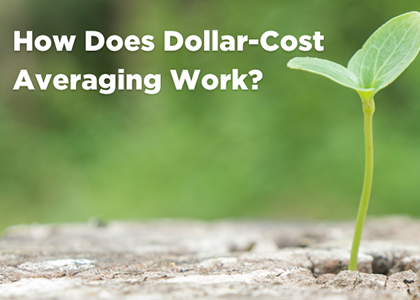When you’re in a traffic jam on the highway, you may find yourself trying to merge into whichever lane is moving fastest at the moment, only to find yourself falling behind drivers that stayed in one lane the whole time. In the same way, you may feel the urge to time the stock market, attempting to put your money in and take it out at just the right moment—a behavior that can work against you.
The market fluctuates, sometimes unpredictably, and often discipline and a steady hand are more effective than attempting a clever trading strategy. Dollar-cost averaging is a simple investing method that can help ensure that you invest regularly and buy more stock when prices are cheap and less when they’re expensive. The strategy helps you avoid making emotional decisions in the heat of the moment and doesn’t require that you pore over research, hoping to anticipate the next market move.
How dollar-cost averaging works
Dollar-cost averaging can potentially soften the effect of market fluctuations and allow you to take advantage of long-term trends. Rather than investing in one lump sum, you put a given amount of money in the stock market on a regular schedule regardless of the way prices are trending. When you do this, you naturally buy more stocks when prices are down and fewer when stocks are up, which can reduce your average cost per share.
Example of dollar-cost averaging
Let’s see what dollar-cost averaging looks like in action. For this example, say you’ve decided to invest $500 in the same stock on the 15th of every month. Because the price is always changing, you end up purchasing different numbers of shares from month to month. A year of investing might look like this:
| Cost per share | Amount invested | Shares purchased | |
| January 15 | $50 | $500 | 10 |
| February 15 | $52 | $500 | 9 |
| March 15 | $35 | $500 | 14 |
| April 15 | $38 | $500 | 13 |
| May 15 | $40 | $500 | 12 |
| June 15 | $45 | $500 | 11 |
| July 15 | $50 | $500 | 10 |
| August 15 | $52 | $500 | 9 |
| September 15 | $54 | $500 | 9 |
| October 15 | $56 | $500 | 8 |
| November 15 | $70 | $500 | 7 |
| December 15 | $80 | $500 | 6 |
| Totals | $6,000 | 118 |
In this scenario, you end up holding 118 shares of stock on December 15, for which you paid an average of $51.83 per share, far lower than the $80 stock price experienced in December. Because you kept the dollar amount the same every month, you naturally purchased more shares as the price per share dropped and fewer shares as it rose back up, winding up with a better average price.
It’s true that you would have paid even less if you had put all $6,000 in on March 15, when the price was lowest. But it would likely have been difficult for you to predict the stock’s low. By using dollar-cost averaging, you gave yourself an advantage, paying a low average stock price, without having to time the market at all.
Disciplined investing
It can be hard to predict short-term market movements, even with sophisticated research and analysis. By making investments on a preset schedule, you reduce the potential for human behavior to adversely affect your strategy—by selling everything after a sudden drop in stock prices and locking in a loss, for example.
Instead, you’ll naturally buy the dip. That is, you’ll buy more after the price drops, lowering your average per-share cost and setting you up to take advantage of potential future gains. What’s more, if thinking about the ups and downs of the stock market makes you nervous, the simple regularity of dollar-cost averaging can help you keep your emotions in check and stay focused on your long-term goals.
SOURCES
https://www.investor.gov/introduction-investing/investing-basics/glossary/dollar-cost-averaging
https://behavioralscientist.org/how-to-save-investors-from-themselves/
https://www.finra.org/investors/insights/three-things-know-about-dollar-cost-averaging
The material provided by Valorem Financial and written by Ocescli, a non-affiliate of Cetera Advisor Networks, LLC, or CWM, LLC.
This piece is not intended to provide specific legal, tax or other professional advice. For a comprehensive review of your personal situation, always consult with a tax legal advisor.
Because dollar-cost averaging involves continuous investment in securities regardless of fluctuating prices, investors should consider their financial ability to continue to purchase through periods of falling prices when the value of their investments may be declining. Dollar cost averaging does not ensure a profit. All investing involves risk, including the possible loss of principal. There is no assurance that any investment strategy will be successful.


